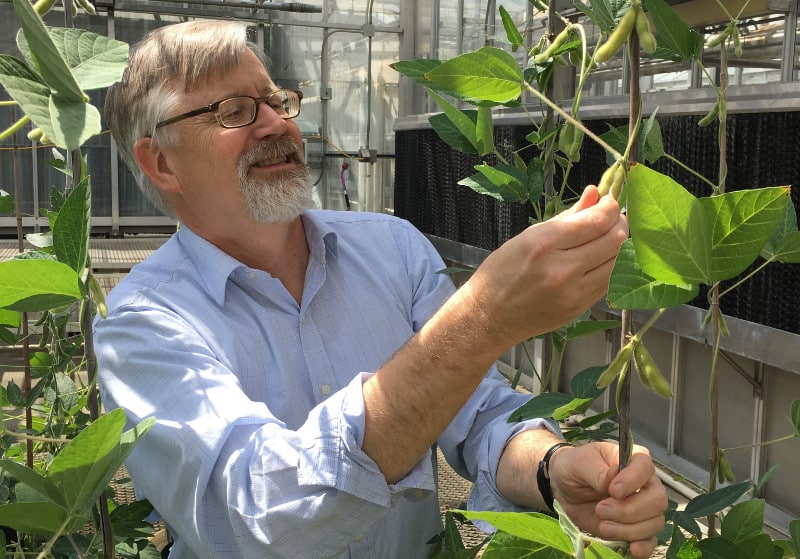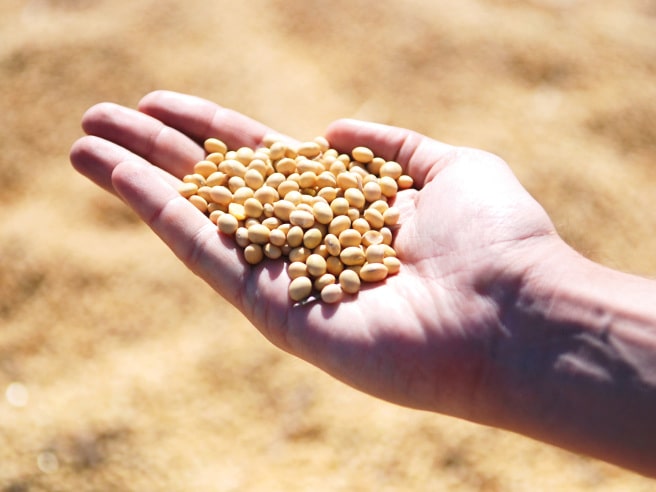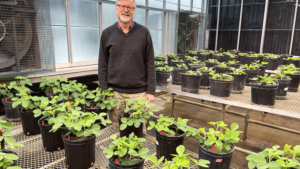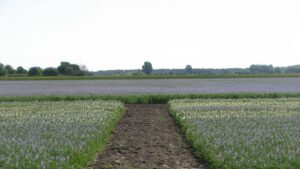How American and Canadian scientists are tackling soy’s biggest breeding problem.
For soybean breeders, coupling high yields with high protein is the Holy Grail, but it’s not likely to happen anytime soon.
In plant breeding terms, the relationship between soybean yield and protein is called “negative” or “inverse”: when breeders select for high-yielding traits, seed protein levels tend to decrease, and when soybean protein is the priority, yields tend to drop.
According to Brian Diers, Charles Adlai Ewing Chair of Soybean Genetics and Breeding at the University of Illinois, the problem comes down to resource allocation in the soybean plant.
“It actually takes a fair amount of energy from the plant to produce protein—it has to fix nitrogen, make amino acids and deposit proteins in the seed,” he explains.
“It requires more energy, for example, than to make carbohydrates. One reason why corn yields are much higher than soybean yields is because the corn kernels are mostly composed of carbohydrates, which is a much less ‘expensive’ product for the plant to produce.”
But although international markets for high-protein soybean meal are growing — food-grade soybean meal is used for tofu in Asian markets — protein has historically tended to lose out to yield in soybean breeding programs on both sides of the border.
In the U.S., Diers says the commodity grain system rewards farmers for yield and not for protein, because farmers are paid based on the weight of grain delivered, not on protein levels. Therefore, there is little incentive for producers to grow lower-yielding, higher-protein soy varieties.
In Canada, the situation is a little different; while producers are also paid for yield, they are paid a premium for growing higher-protein food grade soybean varieties. Premiums differ depending on the buyer, but remain high enough that non-GM, food-grade soy constitutes roughly 30 per cent of the soy market in Ontario, according to Istvan Rajcan, a professor of soybean breeding and genetics at the University of Guelph.
Most Canadian food-grade soy is produced in Ontario and Quebec, with a smaller amount on Prince Edward Island. Further west, most soy is grown for oil crush with meal sold to animal feed, but lower-protein meal still means lower-quality animal feed, and soybean producers are not compensated for higher-protein soybean meal.

The 45% Barrier
In the 1990s, a high-protein soybean variety called Harovinton was developed at Agriculture and Agri-Food Canada’s Research Center in Harrow, Ont. Harovinton yielded 48 to 49% protein in the seed, says Rajcan, but though the variety proved successful with major markets for food-grade soy, it only reached yields of about 85 to 90% of those seen by high-yielding oilseed type soybean varieties at the time.
In the 2000s, the message to the Canadian industry changed, says Rajcan: buyers said they were willing to buy soy at 43 or 44% protein (on a dry bean basis) as long as there were no major yield penalties they’d have to cover with premiums.
The Canadian industry’s research efforts shifted to discovering whether genetics from high-protein breeding material like Harovinton could be combined with that of high-yielding material.

“What we found out was that when one reaches 45 per cent protein and above in the seed, that comes with a yield penalty,” says Rajcan. “Less than 45 per cent, there are some good high-yielding varieties with 44 or 43 per cent protein, and there’s no yield penalty.”
What’s so “magical” about this 45% barrier, Rajcan asks? “There are some genes and alleles that increase protein to those very high levels that happen to be linked on the chromosome with lower yield,” he explains. “When you push the boundaries you’ll have a high protein allele linked tightly on the chromosome with very low yield and the linkage cannot be easily broken. You’ll have a yield penalty.”
Soybean breeders have been criticized in Canada and the U.S., Rajcan says, for failing to produce soy that yields as well as corn. But soy’s yield limitation is physiological: soybean plants simply cannot produce yields as high as corn. And there’s another reason soy yields and yield increases lag behind corn: corn is grown as a hybrid — it is a C-4 plant (meaning higher photosynthetic efficiency) and the plant benefits from hybrid vigour. Soybean, a C-3 plant, is self-pollinated.
Rajcan’s program is entirely focused on conventional non-GM soybeans in order to avoid seed contamination issues. Rajcan’s program makes selections that emphasize yield, hilum colour and soybean cyst nematode resistance. They select large-seeded soybeans good for tofu production but also smaller seed sized soybeans that are high yielding and maintain an average of about 42 to 43 per cent seed protein. They also develop small seeded natto varieties for the Japanese market.
The Way Forward
Diers has been studying quantitative trait loci (QTLs), regions of DNA associated with particular traits, for protein since he was a grad student in the late 1980s. His work is focused on finding QTLs that influence protein and yield so soybean breeders can make better selections.
Diers says there are many genes in soybean that contribute to protein. “Most of these have a very small effect, so if you make a cross between two varieties you’ll observe a distribution of protein among experimental lines,” he explains.
But there are “large-effect” QTLs too, including those found on chromosomes 15 and 20, he adds. The QTL on chromosome 20 has the largest effect on soybean protein, with protein increases up to two per cent — but there’s an associated decrease in seed yield.
Environmental variation does seem to have an impact, however: Diers says some work in the southern states has shown a less negative effect on yield.
Diers believes the path forward in the U.S. will have to involve incentives for farmers to grow higher-protein varieties.
“We see is a range of protein in high yielding germplasm. If there were incentives for farmers to grow just the higher protein varieties, we could make some progress,” he says. “I believe that we will likely see a continued drop in protein levels over time unless there are incentives for focusing more on protein.”
Diers’ program currently tests soybean lines for protein and yield and identifies promising lines. But there are public breeders in the U.S., including at the University of Nebraska, who are looking at diverse germplasm with the goal of increasing soybean protein with minimal impacts on yield.
Private breeders are also focused on the problem.
According to Chris Davison, former head of corporate affairs for Syngenta Canada (he is now head of business sustainability for North America based in Washington, DC), protein levels are influenced by more than just genetics.
“There are a number of factors that determine protein levels that are seen in any given year. They include, but are not limited to, the variety, weather and location of fields,” he says. “As a general rule, fewer days to maturity translates to lower protein levels.”
The key, Davison says, is to get the balance right. “Historically, our focus on protein levels has been driven by our Canadian specific food grade soybean program,” he says. “We currently monitor and screen for protein as part of our research and development program in support of our efforts to develop leading varieties for the different soybean markets that we support, including early maturing varieties in Western Canada.”
Fenggao Dong, North American varietal breeding lead for Bayer, says the company attempts to balance protein, yield, herbicide tolerance and disease resistance in its soybean program in order to maximize overall value for farmers and consumers.
“We are assessing market segments where protein contents need to be prioritized over yield and agronomic traits and adjusting breeding strategies accordingly to make sure our products meet protein requirements,” says Dong. “We are also exploring the data and analytics capabilities in The Climate Corporation to determine if we could make science-based recommendations around weather and agronomic practices to help growers improve protein levels in harvested soybeans.”

Nadia Krasheninnik, a research scientist for Corteva Agriscience, Agriculture Division of DowDuPont, Soybean Product Development Group, says Corteva Agriscience has been collaborating with the United Soybean Board on the Upper Midwest Protein Improvement Initiative for the last four years.
“The objective of this project is to assess the overall viability of developing elite commercial soybean products with an increase in seed protein while maintaining yield and agronomic traits,” says Krasheninnik.¬†”The goal is to increase soybean value for the entire value chain, and to aid in the development of commercial soybean varieties with higher protein levels and an improved nutritional bundle.”
Another key goal of the project, she says, is to understand the relationship between whole bean composition and the nutrient density, or amino acid content, of meals.
Diers says U.S. and Canadian researchers, public and private, have been talking about soybean’s yield/protein negative relationship for more than 30 years — and it’s increasingly top-of-mind. Cross-border collaboration happens in the form of a uniform testing program in which breeders’ best material is evaluated for yield and protein.
Meanwhile, each new variety shows incremental improvements. This past winter, Rajcan’s program alone registered three new varieties: OAC Cooper, OAC Acclaim and OAC Bounty.













